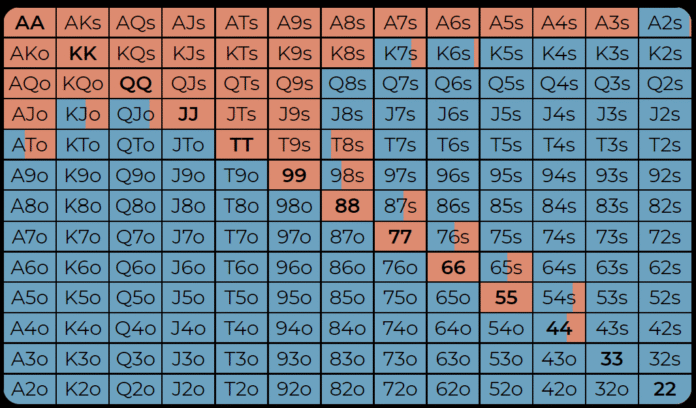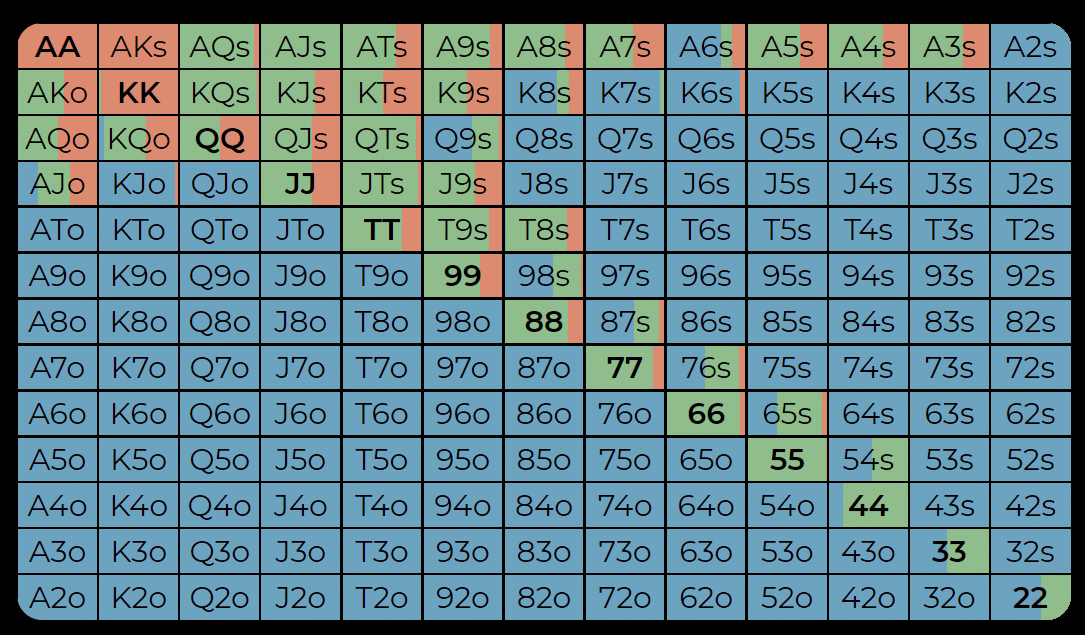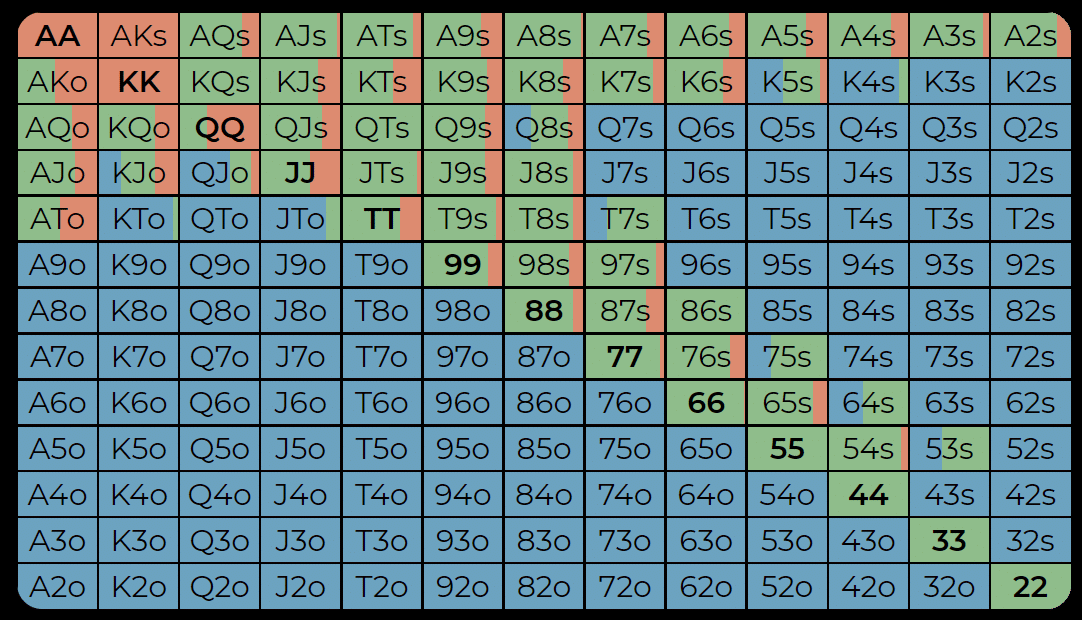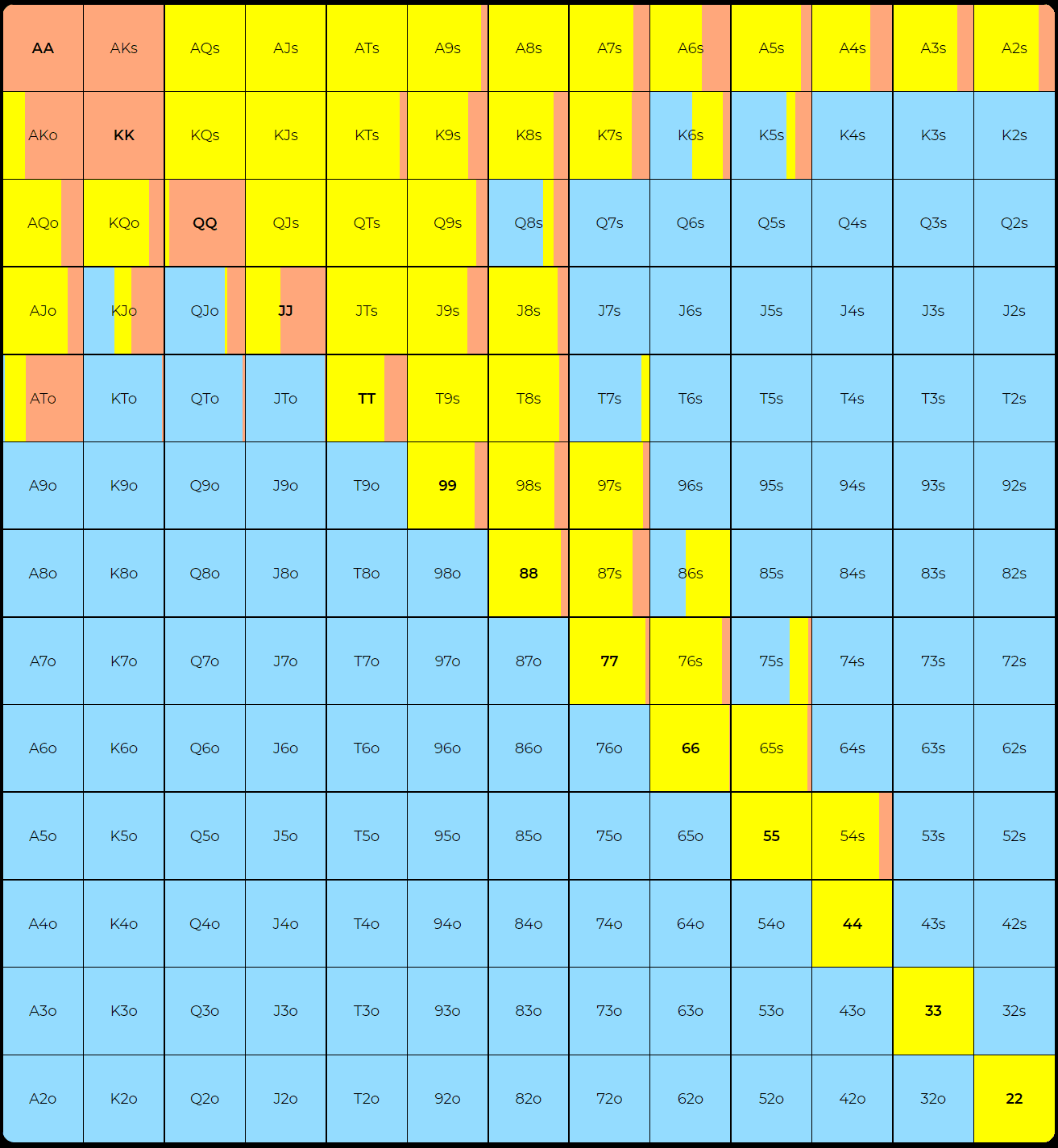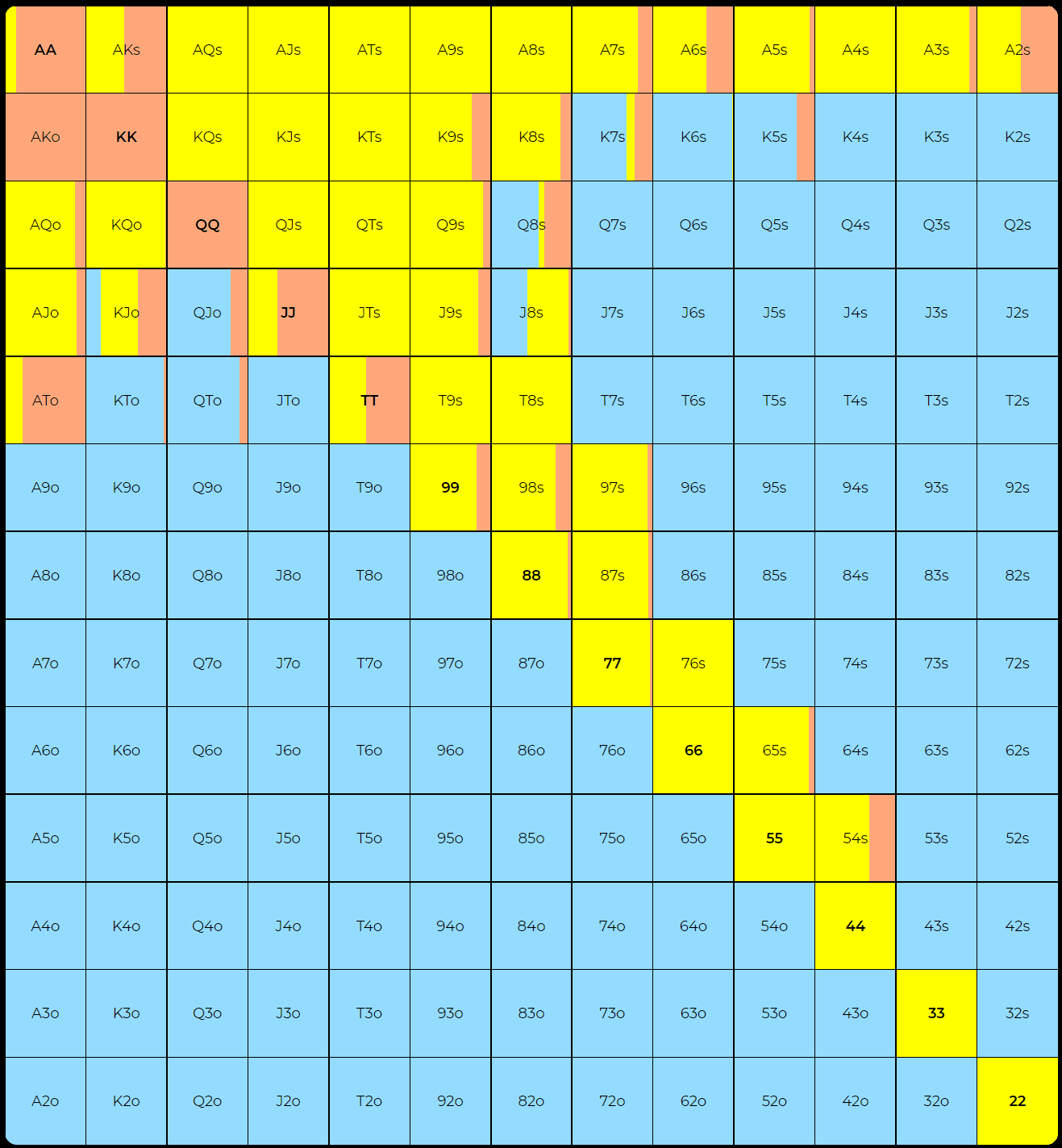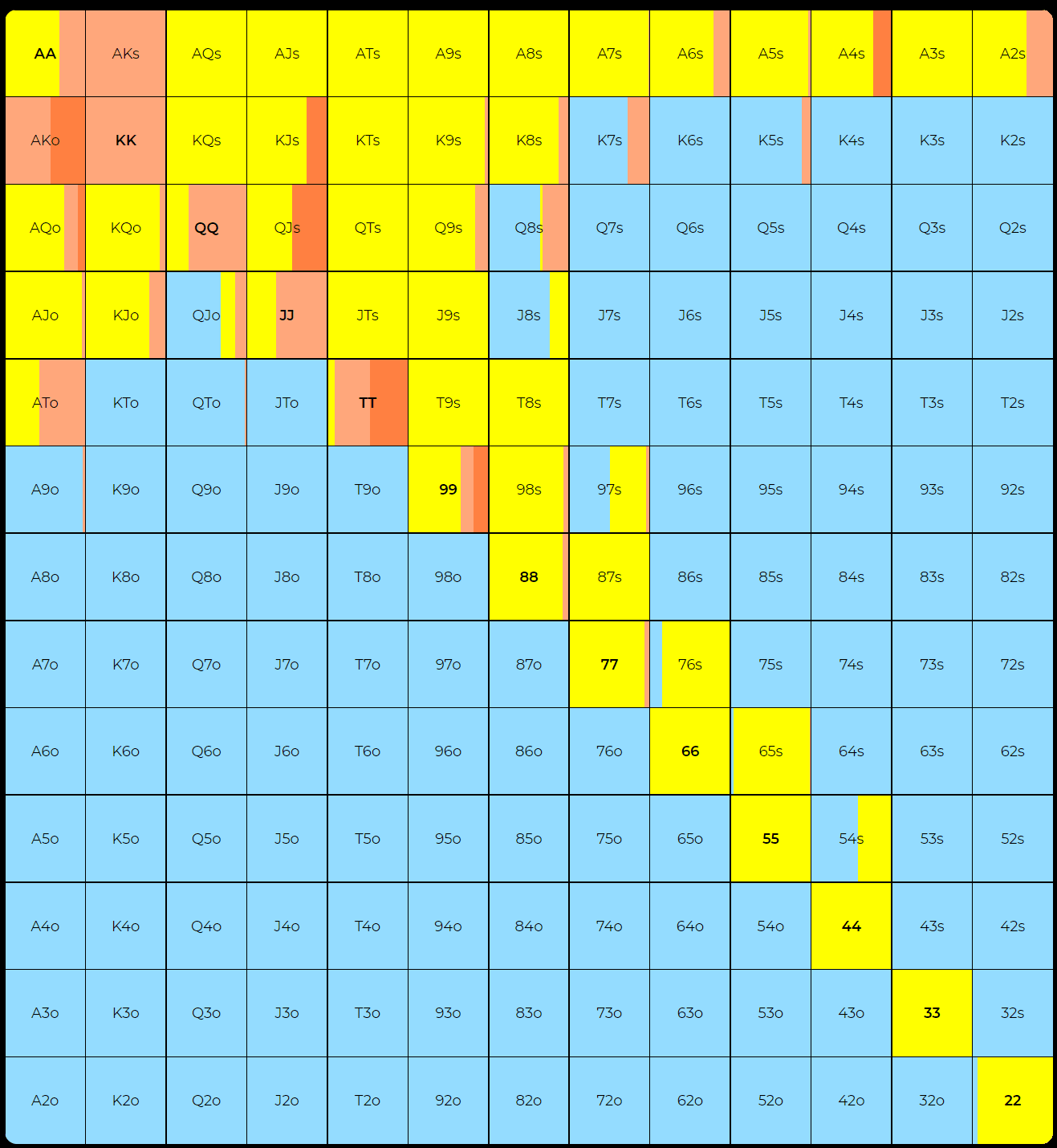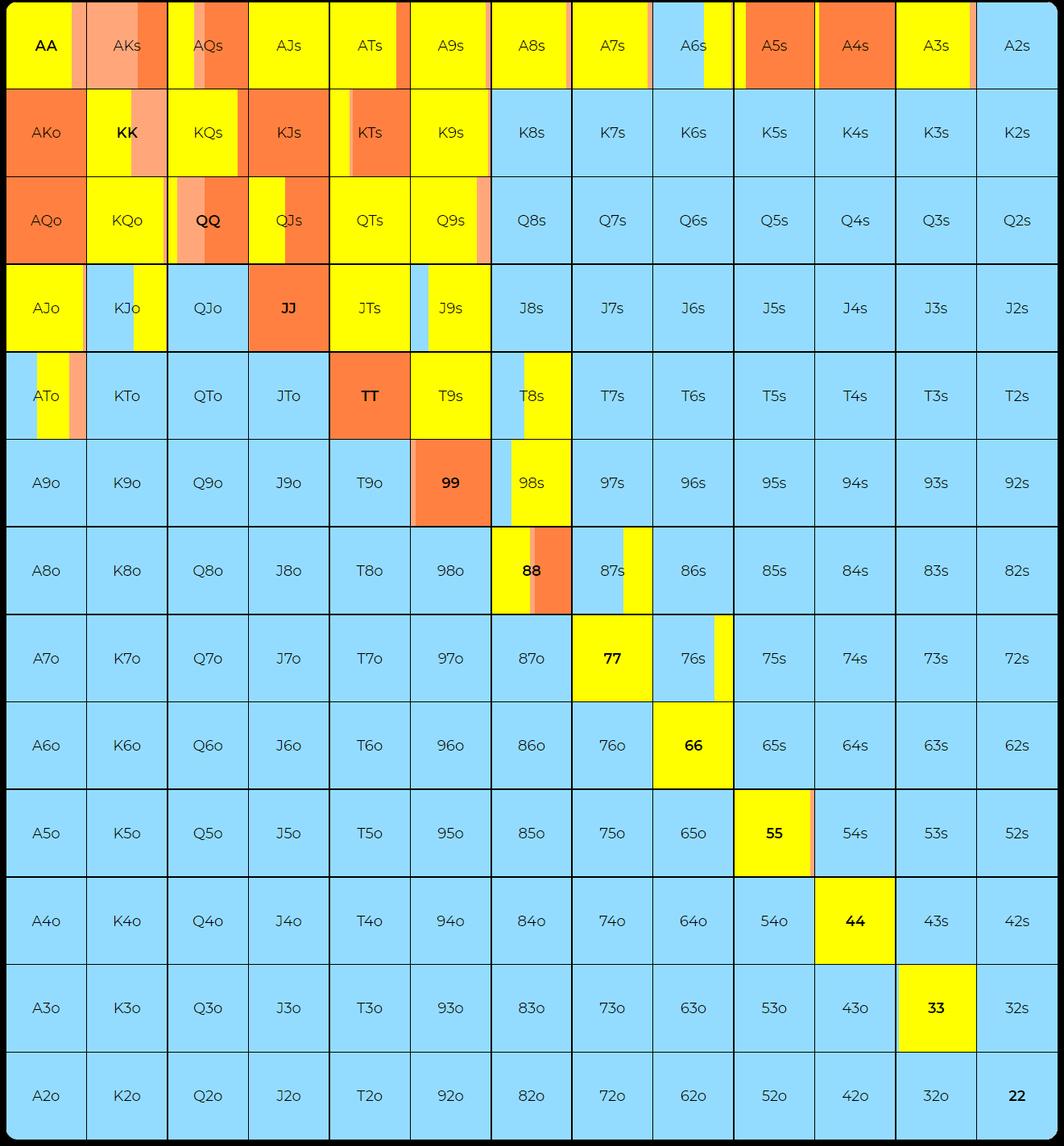Most shedding gamers aren’t bleeding cash due to large, apparent errors.
It’s the small, repeated errors that make or break a profession.
Gradual leaks chip away at your earnings little by little.
One of many greatest? Flatting too vast, and within the incorrect spots.
In right this moment’s article, I’ll present you tips on how to construct strong, theory-driven, profit-generating flat-calling methods.
Flatting Broad: The Mistake That’s Too Simple to Make
Let’s begin with a check.
You’re taking part in 50bb efficient stacks. The UTG participant open-raises, and it folds to you within the Hijack.
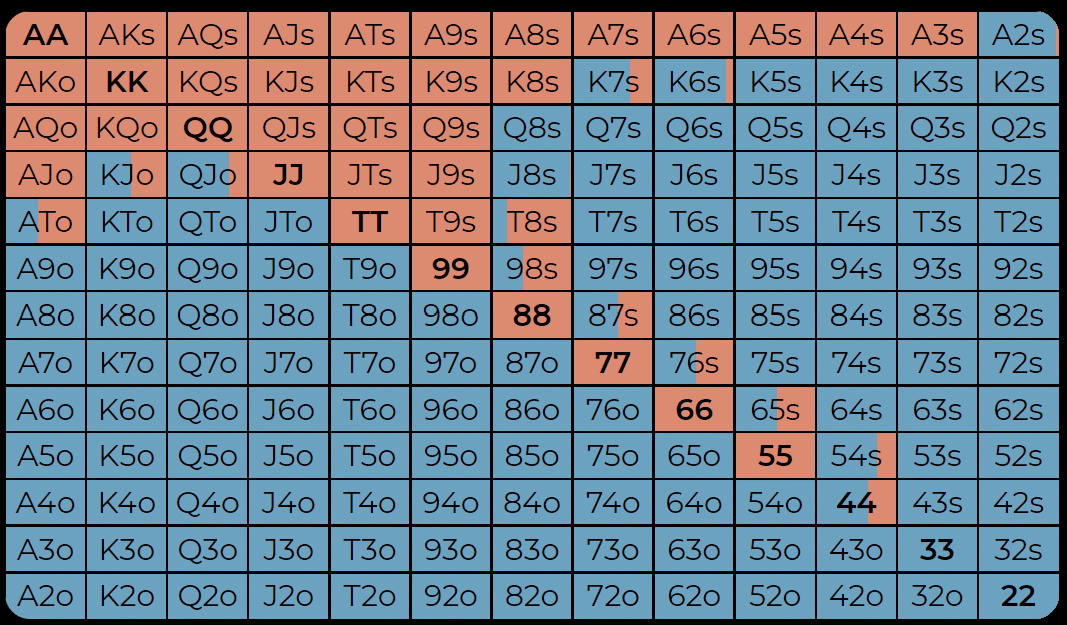
Lucid Poker cEV, 50bb efficient: UTG open-raise technique.
Purple: Increase, Blue: Fold.
Above, you possibly can see UTG’s open-raise technique.
Okay—quiz time.
With out taking a look at a chart, attempt to determine the worst hand in every class that could be a full-frequency VPIP from the Hijack dealing with UTG’s open.
Q1) Pocket Pairs
Q2) Suited Connectors
-
54s
-
65s
-
76s
-
87s
-
Not one of the above
Q3) Suited One-Gappers
This fall) Suited Ax
Q5) Offsuit Broadways
-
QTo
-
QJo
-
KJo
-
KQo
-
Not one of the above
Do you have got your solutions? Examine the chart and reply key beneath to see how you probably did.
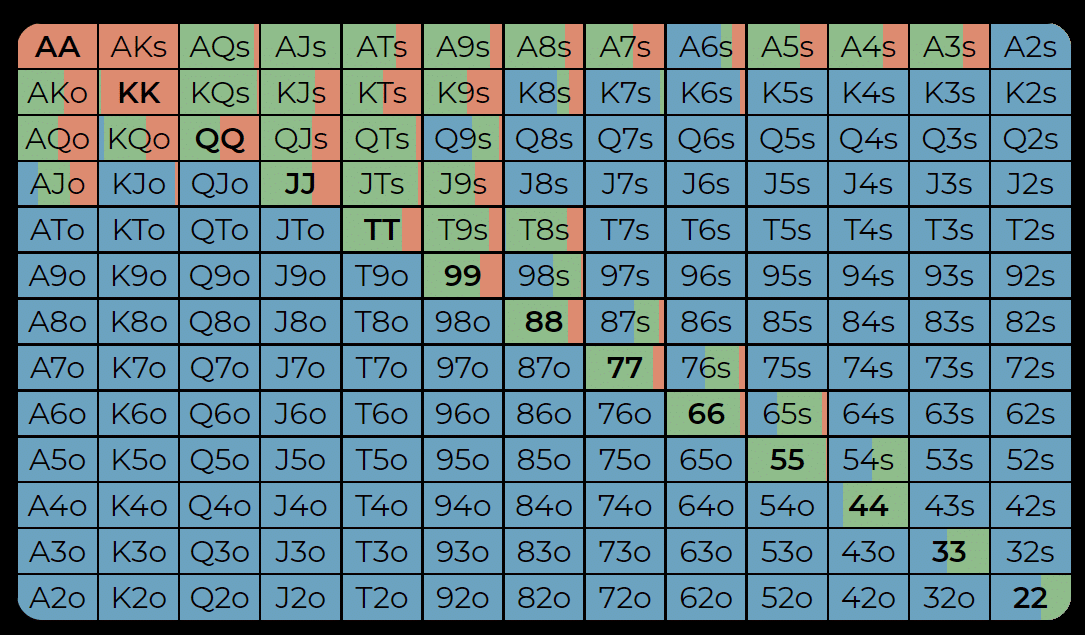
Lucid Poker cEV, 50bb efficient: HJ dealing with UTG open-raise technique.
Purple: 3-bet, Inexperienced: Name, Blue: Fold.
Reply Key
Q1) Pocket Pairs
Reply: #4 — 55 is the underside of the full-frequency VPIPs from the Hijack.
Q2) Suited Connectors
Reply: #5 — Not one of the above. The weakest full-frequency suited connector is T9s. Even 98s is simply a 39% frequency play.
Q3) Suited One-Gappers
Reply: #4 — T8s. 97s is a pure fold.
This fall) Suited Ax
Reply: #2 — A3s. A2s is a pure fold.
Q5) Offsuit Broadways
Reply: #5 — Not one of the above. KJo is a 95% frequency fold, and QJo folds pure. KQo shouldn’t be a full-frequency VPIP, folding 8% of the time.
How did you do?
Not All Flatting Errors Are Equal
For those who bought some solutions incorrect above, that’s okay. The truth is there are two sorts of errors—and one is worse than the opposite.
Frequency vs. Pure Errors
When a combo mixes between calling and folding, it means you’re on the fringe of your vary. Both motion is price zero. So in case you overdid it with suited connectors, pocket pairs, or KQo, don’t really feel too unhealthy.
It’s the pure errors you could fear about.
Pure errors are any actions which might be 0% frequency performs—“it’s not a factor.” This is applicable postflop as effectively.
For instance, within the situation above, ATo and QJo lose EV. KJo, which 3-bets 5% of the time, breaks even when doing so however loses when flat-calling—the zero-frequency play.
Flatting too typically with the proper combos remains to be higher than flatting the incorrect ones.
What Occurs When You Make Frequency Errors Preflop?
Getting preflop frequencies proper issues for the remainder of the sport tree.
Within the situation above, in case you flat-call suited connectors 100% of the time—whereas your opponent wouldn’t be capable to actively exploit you—there are passive results. Since these are bottom-of-range calls, every part stronger in UTG’s vary would achieve a slight bump in EV.
However the impacts aren’t restricted to preflop.
As a result of the densities in your vary have shifted, your vary will carry out higher on some boards and worse on others. For this reason try to be cautious about treating a GTO clear up like divine revelation. In case your opponents make preflop errors, postflop methods can shift dramatically.
Why We Flat-Name
As a class, preflop flatting carries inherent weak spot. By not placing more cash within the pot, you drastically cut back the presence of sure hand lessons—the strongest ones—out of your vary, if not take away them solely. In solver phrases, that is known as having a condensed vary. You might be capped. However being capped doesn’t imply being unprofitable.
That is the important thing level: you flat-call as a result of it makes more cash than folding, and not less than as a lot as 3-betting. You might not have a hand that deserves to bloat the pot, however it does should see the primary three playing cards.
For those who performed solely a fold-or-3-bet technique versus an open, some arms would develop into unprofitable to play. That’s since you’d unnecessarily enhance the fee to see a flop whereas additionally elevating the danger of getting your fairness denied when your opponent 4-bets.
The Ideas You Have to Know to Flat-Name Like A Professional
Professionals don’t rely solely on rote memorization when crafting their in-game responses. Charts are helpful for checking your work, however it’s the underlying ideas that matter most. Beneath are the important thing issues when excited about flatting preflop.
Place and Fairness Realization
Let’s revisit the primary instance the place you’re within the Hijack and evaluate it to the Button’s response.
|
Lucid Poker cEV, 50bb efficient: HJ dealing with UTG open-raise technique. Purple: 3-bet, Inexperienced: Name, Blue: Fold. |
Lucid Poker cEV, 50bb efficient: BTN dealing with UTG open-raise technique. Purple: 3-bet, Inexperienced: Name, Blue: Fold. |
|---|
The Button’s flatting vary widens significantly in comparison with the Hijack’s—17% versus 10%. Whereas it’s apparent that you may flat-call wider the later your place, it’s price contemplating why that’s.
The Button has absolute place, which interprets to increased fairness realization. The Hijack, then again, faces the problem of being sandwiched by the Cutoff or Button in the event that they over-call or 3-bet squeeze. This reduces the Hijack’s total fairness realization. By flatting tighter, the Hijack ensures they’ll nonetheless play profitably when the hand goes multi-way, whereas additionally holding their call-fold frequency low sufficient to face up to squeezes from late place.
Consequently, the Hijack doesn’t flat-call suited connectors at full frequency, whereas the Button may even combine in suited two-gappers (75s, 64s, 53s, T7s, Q8s).
The rule of thumb: the extra gamers left to behave, the tighter you must play.
Domination
Discover a similarity between each ranges: offsuit Broadways are usually not absolutely current—even from the Button.
This highlights the issue of domination. UTG’s vary is full of robust Ax and Broadways. When the weakest offsuit opens in UTG’s vary are KQo and AJo, holding arms like KTo, ATo, QJo, or KJo is a shedding proposition. Solely on the Button does ATo make it in at full frequency, and even then, it’s nonetheless price zero.
A method to consider this: in relation to early place, you could mitigate domination; in relation to the gamers behind you, you could account for fairness realization.
Stack Depth
One other essential issue is stack depth, which may amplify or soften the results of a preflop mistake.
Within the examples above, you’re taking part in 50bb efficient stacks. However what occurs in case you lower the stack depth?
|
Lucid GTO cEV, 40bb efficient: BTN dealing with UTG open-raise technique. Purple: 3-bet, Yellow: Name, Blue: Fold. |
Lucid GTO cEV, 30bb efficient: BTN dealing with UTG open-raise technique. Purple: 3-bet, Yellow: Name, Blue: Fold. |
|---|---|
|
Lucid GTO cEV, 25bb efficient: BTN dealing with UTG open-raise technique. Darkish Purple: All-in, Mild Purple: 3-bet, Yellow: Name, Blue: Fold. |
Darkish Purple: All-in, Purple: 3-bet, Yellow: Name, Blue: Fold. |
Within the desk above, you possibly can see the Button’s response to UTG’s open throughout stack depths—beginning at 40bb efficient (prime left) right down to 25bb (backside proper). A transparent sample emerges: as stacks shrink, suited and related combos contract.
At 50bb, 86s (a suited one-gapper) flat-called 100% of the time and was price a nominal +0.01bb. At 40bb, 86s drops to simply over half frequency. At 30bb, it disappears altogether. As stack depth decreases additional, the weakest one-gapper turns into T8s—and even then, not at full frequency—whereas stronger suited connectors additionally begin folding extra typically. By 20bb, 86s really loses –0.08bb if you name.
Discover, nevertheless, that offsuit Broadways don’t contract almost as a lot as suited arms. That’s as a result of this hand class performs about the identical versus UTG’s vary whether or not stacks are 20bb or 50bb, since UTG’s opening vary stays comparatively static (round 17%). Every time your Broadways make prime pair, stacking off—or shedding a large pot—is usually advantageous, even a bit deeper.
In contrast, the suited area suffers closely at shorter stacks. These arms profit from stack leverage and carry out finest in multi-street conditions. With much less depth, their fairness realization drops off dramatically.
Little stacks like massive playing cards. Large stacks like little playing cards.
Abstract
When growing flat-calling ranges, maintain the next components in thoughts:
- The Opener’s Vary: How typically is your hand dominated by the underside of their vary throughout the identical hand class? How does it carry out towards the remainder of their holdings? If the solutions are “typically” and “poorly,” you have got a fold.
- The Gamers Behind: How possible are your opponents to over-call or 3-bet squeeze? The upper the danger of multi-way motion or a worth hike if you’re out of place, the stronger your flatting vary must be.
- Stack Depth: How does your hand carry out at this depth? Bear in mind: offsuit excessive playing cards retain worth when stacks are shallow, whereas suited, related, draw-type arms require extra depth to justify taking part in.
And don’t fear—no one will get it excellent each time.
Good luck!
For those who’d wish to be taught extra about strategically folding in MTTs, learn: Examine or Guess? Construct Sturdy Flop Examine-Again Methods in Tournaments.

